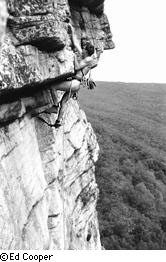 ™
™TRADITIONAL MOUNTAINEERING
™
www.TraditionalMountaineering.org
™ and also
www.AlpineMountaineering.org
™
 ™
™
FREE BASIC TO ADVANCED
ALPINE MOUNTAIN CLIMBING INSTRUCTION™
Home
| Information
| Photos
| Calendar
| News
| Seminars
| Experiences
| Questions
| Updates
| Books
| Conditions
| Links
| Search
![]()

Charter Vulgarian Dick Williams makes the first
nude ascent of Shockley's Ceiling, in 1964.
His buddies took off with his clothes so his descent was also a first.
The History
Rock climbing among the Shawangunk Mountains dates back to 1935 when Fritz
Wiessner, a German immigrant and accomplished mountaineer, established the first
rock-climbing route. Called "Old Route," it is located at Millbrook, the
tallest, most remote, southernmost cliff of the Shawangunk Ridge. Not long
after, Wiessner ventured to the northern region of the cliffs and established
several additional classic routes, including "Lakeview" on Skytop. One of the
most instantly recognizable symbols of the Shawangunks, Skytop juts above
skyline, its signature profile cliffs with the stone tower on top boldly stands
out against the horizon. Currently, it is illegal to climb on Skytop.
Wiessner, along with frequent climbing partner Hans Kraus, focused on climbing
the Trapps and the Near Trapps, the two central cliffs of the Shawangunk Ridge.
Named for the Dutch word for steps, the Trapps is the most popular climbing
cliff today. It is the longest of the Gunks' cliffs, varying in height from 30
to 250 feet along its length. Together, the Trapps and Near Trapps have the
greatest concentration of climbing routes at the Gunks; they are also the most
accessible of the cliffs.
In 1941, Wiessner and Krauss were the first to climb "High Exposure" in the
Trapps. Today, this route is considered by many to be the single best rock
climbing route in the world for its level of difficulty. Because of this awesome
reputation, and its incredible photogenic character, this classic usually makes
its way onto almost every list of "must-do" routes for visiting climbers. While
Wiessner and Kraus left an indelible mark in the annals of early Shawangunk
climbing history, the Appalachian Mountain Club became the dominant climbing
force in the 1950s. Next came the Vulgarians, who entered the scene in 1958. A
controversial group of climbers, most of the Vulgarians were college students
from New York City. They developed a notorious reputation for wild stunts on the
cliffs, including climbing in the nude.
Following the Vulgarians, climbing at the Gunks continued to progress. Improved
climbing equipment and ever-increasing standards resulted in a proliferation of
new routes, many of them among the hardest in the world at the time. As such,
the Gunks' reputation spread, and by the 1980s the Gunks were firmly established
as a world-renowned climbing destination.
The Gunks Today
In the early years, access to the Gunks' cliffs wasn't a problem-the cliffs were
there, and people climbed them. Today, however, the Shawangunk Ridge is a
conglomeration of privately and publicly held lands, each with different rules
and regulations governing climbers' rights and privileges to embark on a journey
into the vertical world.
Access aside, ask any climber and they'll tell you that the centerpiece and
crown jewel of Shawangunks rock climbing today is the Mohonk Preserve. Recently
named one of "The Best City Escapes" by Outside magazine, it is New York State's
largest privately funded nature preserve. More than 6,400 acres of dramatic
mountain ridge play host to outdoor and nature enthusiasts alike-25 miles of
carriage roads and 31 miles of hiking trails lie within the preserve's borders,
along with the Trapps and Near Trapps cliffs. Over 100,000 people visit the area
each year to hike, bicycle, cross-country ski, enjoy the natural surroundings,
and, of course, rock climb. In fact, nearly half of the preserve's members are
climbers, who account for more than 40,000 visits a year.
Peter Bronski is a freelance writer and native of New York State. He works as
an ecologist when he's not busy hanging from a cliff.
Richard Williams:
One of the founding members of the Vulgarians, a group of climbers that went
against the establishment at the Shawangunks in the early 1960s. Decided that
climbers did not need to be licensed and qualify to climb routes, and climbed
hundreds of first ascents of high difficulty at the Gunks. He was also the
author of the first definitive guidebook covering the Gunks. A great climber and
contributor to the history of climbing in the Shawangunks.
Copyright 1996 by Smithsonian Magazine. All rights reserved.
![]()
![]()
![]() WARNING - *DISCLAIMER!*
WARNING - *DISCLAIMER!*
Mountain climbing has inherent dangers that can in part, be mitigated
Read More
Top rope climbing in the 1970s
ESSENTIAL PERSONAL GEAR
What does Steve House wear for light and fast climbing?
What clothing do you wear for Light and Fast winter mountaineering?
What do you carry in your winter day pack?
Photos?
![]()
Which digital camera do you use in the mountains?
What about Boots and Shoes?
![]()
TRADITIONAL KNOWLEDGE
How did you become interested in traditional mountaineering techniques?
Who is Conrad Messner?
What is traditional slacklining or highlining?
What are some of the comments you have received?
Who was Peter Starr?
Who are the Mazamas?
What is an avalanche cord?
Who were the notorious Vulgarians?
How was top rope climbing practiced in the 1970s?
What is a Whillans sit harness?
What is a dulfersitz rappel?
How do I self-belay a rappel?